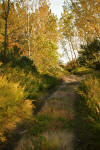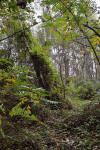 |
 |
 |
 |
 |
 |
Nature Untamed: Liberty State Park’s Interior Natural Area Continues its Comeback
“…the assemblage of plant life and the subsequent novel communities in
Liberty State Park suggest a balance between invasive and native species
cooperatively coexisting.”
By Matt
Hunger
In its 34 years of existence, Liberty State Park has lived with approximately 250 acres of contaminated land, fenced off with signs warning of hazardous material. When the park was founded in 1976, there were few expectations that the area would ever recover from its past. Tainted with industrial waste, the swath seemed relegated to little more than an unsightly reminder of industrial recklessness.
But now, after ten years of public debate, environmental studies, and an approved plan in place for a $32 million dollar massive wildlife development project, the area — known as the Interior Natural Area — is set to re-open. And this Saturday, the park will give its second-ever public tour of the area and its dramatic environmental recovery.
The Friends of Liberty State Park is sponsoring a Nature Program, including a talk and guided tour into the area. The talk, given by Dr. Frank Gallagher and Dr. Claus Holzapfel, both of Rutgers University, will be an overview of the scientists’ work in the area, a look at the collusion of native and non-native species in reviving the once devastated area, as well as to address future development. This development plan, to be carried out by the Army Corps of Engineers, includes the creation of freshwater wetlands, a salt marsh, and the developing of 100-acres of evolving forest, all by utilizing land and waterways already in existence.
Following the talk, a guided tour of the newly opened area, also led by Gallagher and Holzapfel, will examine the plant life that has survived, and in some cases flourished, despite the industrial waste.
Gallagher, state Division of Parks and Forestry administrator who has worked with the park since 1983, first conducted a natural resource inventory of the contaminated area in the mid-1990s when discussions over what to do with the unused land re-emerged. Expecting very little, he was surprised at how well certain plant species were able to eke out an existence in an area thought to be too contaminated to allow for much plant growth.
“What interests me the most is which species of plants and animals don’t do well and the number that do, and have acclimated to the conditions,” he says.
Certain plants can absorb the land’s hazardous materials and sequester the toxins such that they will no longer be in the soil nor damage the plant. This was the first unforeseen step towards the area’s recovery, which in turn allowed more fragile plants to emerge. And with renewed plant life there is renewed animal life as well.
“We’ll talk about bird sightings [on Saturday],” Gallagher says. ”It’s the fall migration so there should be some raptors, red tails and cooper hawks, maybe an osprey will fly by or some other pretty big bird.” The area’s development plan will ultimately include the construction of bird blinds, enclosures that allow birdwatchers to view birds without being spotted.
A Long Fight for Open Space
This wild area of Liberty State Park is in many ways emblematic of the park’s history. Built predominantly on reclaimed landfill and abandoned railroad tracks, the park’s stewards have continually fought off commercial interests in their mission to preserve open space in densely populated Jersey City.
In June of 1958, while former Jersey City councilman Morris Pesin (on City Council from 1969-1977) walked through the heaps of garbage strewn along an area of the Jersey City waterfront, his son, Sam Pesin, was sitting in school unaware what this would mean for his future. Morris Pesin’s planned stunt, with the help of a sympathetic editor at the Jersey Journal, was to meet with a Journal reporter and together row a canoe out to Liberty Island.
The publicity, they thought, would call attention both to the nearness of the Statue of Liberty to New Jersey, as well as the waterfront’s state of disarray — two issues that would come to define much of both the elder and younger Pesins’ lifework. So the civic activist and reporter, paddles in hand, set out on the 8-minute-long expedition to the island, taking the first of many steps towards today’s Liberty State Park, even as they rowed away from it.
“My father wanted to know,” says Sam Pesin, now the president of the Friends of Liberty State Park, the volunteer-based nonprofit organization dedicated to the park, “if it’s so close, why shouldn’t we be able to get to Liberty Island from New Jersey?”
Morris Pesin also wanted to know why New York City’s Battery Park looked the way it did, and Jersey City’s waterfront could not.
A year before the canoe voyage, the Pesin family had taken a frustrating car
trip from Jersey City — via Holland Tunnel traffic, New York City parking,
and bad timing on a near-missed ferry — to Liberty Island.
“My father looked westward and he saw this shameful backdrop to the Statue
of Liberty on the New Jersey side, an eyesore on the Jersey City shoreline,
a waterfront wasteland and abandoned rail yards,” Pesin recalls. “He had the
idea there should be a beautiful background to the Statue of Liberty there.”
So frustrated at their experience, and so embarrassed by the view of Jersey City’s waterfront from the island, Morris Pesin made it a priority to clean the abandoned former industrial area and have a park put in place — one worthy of the view, and equally important, with some kind of access to the island. The Statue of Liberty is, after all, closer to New Jersey than it is to New York. This would prove longer, and would involve more rowing, than he had likely anticipated.
In fact, when the initial voyage wasn’t enough, Pesin took another canoe trip to Liberty Island, this time in 1961 to celebrate the Statue of Liberty’s 75th birthday. From the time of this trip, however, it would still be another 15 years before the park would officially open, coinciding with the country’s 200th birthday and the generous budget allocation that comes with centennial celebrations. Finally, it seemed, Pesin’s vision — with the help of Friends co-founder Audrey Zapp and their burgeoning coalition of open-space partisans — would come to pass in the form of a clean and public park appropriate to its setting.
But even then, it would be only another year before Zapp and Pesin had to re-form their coalition, this time to counter then-Governor Byrne’s plan, as Sam Pesin remembers it, to allow the governor’s friend to use the land to build an amusement park. The park stewards won that battle, but would have to fight several more over the next few decades.
In the ’90s, there were plans for a golf course that found an eventual and unlikely opponent in Gov. Christie Todd Whitman. Groups like Friends of Liberty State Park were joined by NY/NJ Baykeeper, a nonprofit dedicated to protecting area waterways, and were quick to remind the governor of the public’s disapproval of commercial use of public space.
“People fought like hell,” says Pesin of the August 1994 public hearing on the proposed golf course. ”Six-hundred people came out to the hearing at the railroad terminal, the vast majority against the golf course plan. And two weeks later we got a busload of people to the August 25 hearing in Trenton.”
Not long after followed a plan for a water park with the approval of then-mayor Bret Schundler. The initial plans for the commercial water park projected an estimate of 5,000 swimmers a day.
“Why can’t we take 20 acres out of 225 acres and do something that creates more recreation opportunities?” Schundler was quoted as saying at the time.
But as NY/NJ Baykeeper deputy executive director and conservation director Greg Remaud explains, the proposal would have disrupted the area’s fragile ecology.
“There would have been an active recreational water park between the Science Center and the natural restoration area, which would have negatively affected the environment,” he says. “We’re doing an integrated restoration, which in fact enhances the water lands by collecting runoff water both from the roof of the Science Center and the parking lot. We will capture this water and clean it for use to support freshwater wetlands. Breaking up the continuity by putting in a water park would have made this impossible.”
Lessons for the World
Though the diverse Interior Natural Area is now safe for public use, via a combination of natural occurrence and continual cleanup, the full restoration of the wetlands and salt marsh is still several years away.
“We hope to break ground in the spring,” says Gallagher of the first stage, for which approximately $10 million has already been distributed. “The Army Corps of Engineers will start first with the wetlands, which will take about 18 months.”
But that is just one part of the project; a majority of the $32 million dollars it will cost for the entire revamp has yet to arrive. Although much of it has been federally earmarked, it is pending the allocation of funds from the federal Water Resources Development Act of 2007.
“Hopefully in three to five years, after the rest of the money is given, they can begin work on the salt marsh,” Gallagher continues.
Regardless, studies by Gallagher and Holzapfel of the rich natural assemblages of the “novel communities” of plant life will continue.
“Some areas I like to show are novel areas that you won’t find anywhere else,” says Holzapfel. ”This is kind of exciting from a scientific point of view, but also transmits to the general public that this is actually a model of a new world to come and we should know about that.”
Both scientists say their findings have potential for a more global purpose. While bioremediation — the use of plants to extract metals from soil — is not new, the assemblage of plant life and the subsequent novel communities in Liberty State Park suggest a balance between invasive and native species cooperatively coexisting.
“There probably are a lot of vacant industrial lands and plots in the country where novel assemblages would do quite well, where these plants could exist in somewhat toxic soil,” says Gallagher. “Let’s face it, we’re in an era where human impact is extensive, where no area in the world has not been impacted by human development — and along with that development comes disturbance of soil. The processes we observe here are applicable on a broad scale.”
THE DETAILS
Saturday’s free program begins at 1 pm with a program at the park’s Nature Interpretive Center; at 2:15 pm the scientists will lead a walk into the Interior. For more information, call 201-792-1993 or email pesinliberty (at) earthlink.net
Please see our brochure